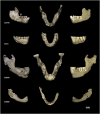Tooth wear and dentoalveolar remodeling are key factors of morphological variation in the Dmanisi mandibles
- PMID: 24101504
- PMCID: PMC3808665
- DOI: 10.1073/pnas.1316052110
Tooth wear and dentoalveolar remodeling are key factors of morphological variation in the Dmanisi mandibles
Abstract
The Plio-Pleistocene hominin sample from Dmanisi (Georgia), dated to 1.77 million years ago, is unique in offering detailed insights into patterns of morphological variation within a paleodeme of early Homo. Cranial and dentoalveolar morphologies exhibit a high degree of diversity, but the causes of variation are still relatively unexplored. Here we show that wear-related dentoalveolar remodeling is one of the principal mechanisms causing mandibular shape variation in fossil Homo and in modern human hunter-gatherer populations. We identify a consistent pattern of mandibular morphological alteration, suggesting that dental wear and compensatory remodeling mechanisms remained fairly constant throughout the evolution of the genus Homo. With increasing occlusal and interproximal tooth wear, the teeth continue to erupt, the posterior dentition tends to drift in a mesial direction, and the front teeth become more upright. The resulting changes in dentognathic size and shape are substantial and need to be taken into account in comparative taxonomic analyses of isolated hominin mandibles. Our data further show that excessive tooth wear eventually leads to a breakdown of the normal remodeling mechanisms, resulting in dentognathic pathologies, tooth loss, and loss of masticatory function. Complete breakdown of dentognathic homeostasis, however, is unlikely to have limited the life span of early Homo because this effect was likely mediated by the preparation of soft foods.
Keywords: aging; compensatory mechanisms; early Pleistocene Homo; local periodontitis; toothpick.
Conflict of interest statement
The authors declare no conflict of interest.
Figures




Similar articles
-
On the variability of the Dmanisi mandibles.PLoS One. 2014 Feb 20;9(2):e88212. doi: 10.1371/journal.pone.0088212. eCollection 2014. PLoS One. 2014. PMID: 24586309 Free PMC article.
-
Comparative analysis of dentognathic pathologies in the Dmanisi mandibles.Am J Phys Anthropol. 2016 Jun;160(2):229-53. doi: 10.1002/ajpa.22966. Epub 2016 Feb 26. Am J Phys Anthropol. 2016. PMID: 26919277
-
On dental wear, dental work, and oral health in the type specimen (LB1) of Homo floresiensis.Am J Phys Anthropol. 2011 Jun;145(2):282-9. doi: 10.1002/ajpa.21492. Epub 2011 Mar 16. Am J Phys Anthropol. 2011. PMID: 21412994
-
Dental evidence for the diets of Plio-Pleistocene hominins.Am J Phys Anthropol. 2011;146 Suppl 53:47-62. doi: 10.1002/ajpa.21610. Am J Phys Anthropol. 2011. PMID: 22101687 Review.
-
The diets of early hominins.Science. 2011 Oct 14;334(6053):190-3. doi: 10.1126/science.1207701. Science. 2011. PMID: 21998380 Review.
Cited by
-
A Force on the Crown and Tug of War in the Periodontal Complex.J Dent Res. 2018 Mar;97(3):241-250. doi: 10.1177/0022034517744556. Epub 2018 Jan 24. J Dent Res. 2018. PMID: 29364757 Free PMC article. Review.
-
A Critical Evaluation of the Down Syndrome Diagnosis for LB1, Type Specimen of Homo floresiensis.PLoS One. 2016 Jun 8;11(6):e0155731. doi: 10.1371/journal.pone.0155731. eCollection 2016. PLoS One. 2016. PMID: 27275928 Free PMC article.
-
On the use of dental microwear texture analysis to determine etiology and assess wear of dental tissues for clinical evaluation.Biosurf Biotribol. 2025 Jan-Dec;11(1):e12089. doi: 10.1049/bsb2.12089. Epub 2024 Dec 19. Biosurf Biotribol. 2025. PMID: 40831462
-
Broad-scale morpho-functional traits of the mandible suggest no hard food adaptation in the hominin lineage.Sci Rep. 2020 Apr 22;10(1):6793. doi: 10.1038/s41598-020-63739-5. Sci Rep. 2020. PMID: 32322020 Free PMC article.
-
On the variability of the Dmanisi mandibles.PLoS One. 2014 Feb 20;9(2):e88212. doi: 10.1371/journal.pone.0088212. eCollection 2014. PLoS One. 2014. PMID: 24586309 Free PMC article.
References
-
- Kaifu Y. Was extensive tooth wear normal in our ancestors? Anthropol Sci. 2000;108(4):371–385.
-
- Scott RS, et al. Dental microwear texture analysis shows within-species diet variability in fossil hominins. Nature. 2005;436(7051):693–695. - PubMed
-
- d’Incau E, Couture C, Maureille B. Human tooth wear in the past and the present: Tribological mechanisms, scoring systems, dental and skeletal compensations. Arch Oral Biol. 2012;57(3):214–229. - PubMed
-
- Scott RS, Teaford MF, Ungar PS. Dental microwear texture and anthropoid diets. Am J Phys Anthropol. 2012;147(4):551–579. - PubMed
Publication types
MeSH terms
LinkOut - more resources
Full Text Sources
Other Literature Sources

